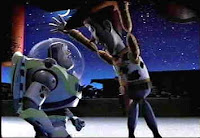Recently we had an animation field trip to see Monsters vs Aliens.
Some discussion resulted.
The Character Design Blog has put together this video featuring some of the artwork for the movie. I know the first years, in particular, love to illustrate and really good way to direct that passion is toward character design for animation.
Thursday, April 30, 2009
Wednesday, April 29, 2009
Non-verbal communication
It has been stated by scholars who study body language that 60 to 80% of human communication is through non-verbal communication, or body language.
In terms of animation, that adds some meaning as to why some animation communicates so well without dialogue and why we love, for example, French animation, or Japanese animation so much. See the post about Shane Acker's short film "9" (below), as a recent example of animation that communicates without dialogue.

Ian Lacey (Animation Resource Centre) always encourages his students, who seek to be character animators, to animate what the character is thinking.
Acting for Animators author, Ed Hooks, also describes it as essentially important.
The important communication is displayed through the character's body language.
The animation is particularly delicious when the dialogue was in contradiction to how the character was communicating non-verbally. It can drive a whole story in the opposite way to the characters' dialogue thus giving insight or unease to the audience. The animator is the one who controls it.
I think it is important for animation students to realise the importance of recognising non-verbal communication as a skill. Firstly, in terms of observation. Observation being: seeing + thinking about what you are seeing. And secondly in looking to thoughtfully apply techniques, such as: facial touching gestures, psychological gestures, line of action reversals, power centre shifts, meaningful symbolism to every opportunity in animating.
Hey, those things sound familiar don't they? Psychological Gestures, Line of Action, Power Centres, Meaningful Symbolism... they all relate to posing in story telling poses (click for a great resource .mov download from Keith Lango).
Many of you have probably already seen this video on body language (I'm sure Dan might like it for the music ;) ) ...
An interesting experiment for student animators is to search video sharing sites for video reference on body language. You will pick up some good ideas and maybe even someone at a nightclub.
In terms of animation, that adds some meaning as to why some animation communicates so well without dialogue and why we love, for example, French animation, or Japanese animation so much. See the post about Shane Acker's short film "9" (below), as a recent example of animation that communicates without dialogue.

Ian Lacey (Animation Resource Centre) always encourages his students, who seek to be character animators, to animate what the character is thinking.
Acting for Animators author, Ed Hooks, also describes it as essentially important.
The important communication is displayed through the character's body language.
The animation is particularly delicious when the dialogue was in contradiction to how the character was communicating non-verbally. It can drive a whole story in the opposite way to the characters' dialogue thus giving insight or unease to the audience. The animator is the one who controls it.
I think it is important for animation students to realise the importance of recognising non-verbal communication as a skill. Firstly, in terms of observation. Observation being: seeing + thinking about what you are seeing. And secondly in looking to thoughtfully apply techniques, such as: facial touching gestures, psychological gestures, line of action reversals, power centre shifts, meaningful symbolism to every opportunity in animating.
Hey, those things sound familiar don't they? Psychological Gestures, Line of Action, Power Centres, Meaningful Symbolism... they all relate to posing in story telling poses (click for a great resource .mov download from Keith Lango).
Many of you have probably already seen this video on body language (I'm sure Dan might like it for the music ;) ) ...
An interesting experiment for student animators is to search video sharing sites for video reference on body language. You will pick up some good ideas and maybe even someone at a nightclub.
Why do you have that blog?
 OK people here's the thing.
OK people here's the thing.You have an animation student blog for an important reason.
Because I say so. :)
The reason I say so is: so I can see how you are progressing in your class work by asking you to post work completed as class tasks.
Animators should practice getting them on (your blog) within the deadline... set for the class assessment tasks.
If you have an itchy spot that is telling you, "I think I should have posted some work up on my blog under the heading 'Assessment'", well you may very well be correct.
The work you post is some of the proof that you are doing the work to become a good animator and end up with a qualification. Y'see you give me proof that you're doing the work. I organise for you proof that you have done the work (a lovely framed certification from the best dang animation course in Queensland).
Check the class task sheets on Blackboard to see what should be posted on your blog.
The stimulus to make this post is an educational one as well.
Why do you have a blog? Maybe it can work for you... learn more from Karen J Lloyd's Storyboard Blog (it's a blog you should get used to visiting as their is a lot of good stuff there).
Friday, April 24, 2009
9
I look forward to seeing this animated feature film later in 2009! You have to endure the advert to see the animation. But it's worth it.
Shane Acker's original short film animated without dialogue:
Shane Acker's original short film animated without dialogue:
Subscribe to:
Posts (Atom)